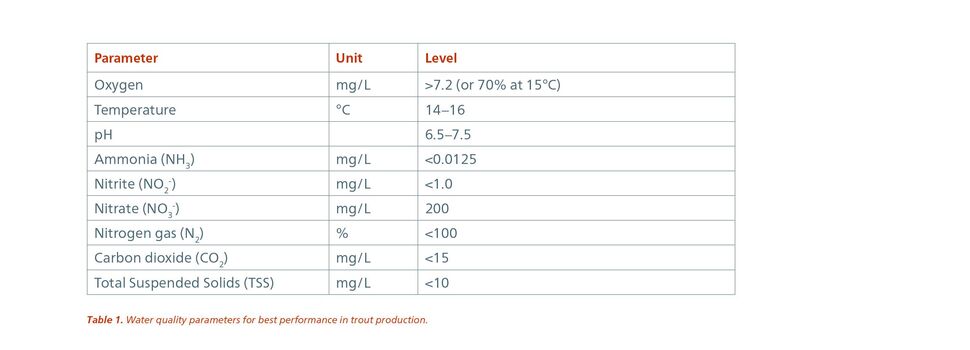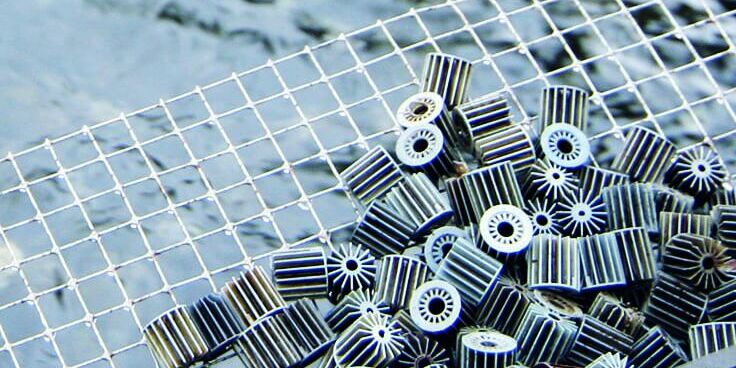
In all types of fish farming — and especially in RAS — water quality is the basis for healthy fish and optimal performance.
Fish will eat and grow well when the water quality is excellent and consistent. Water quality, to a great extent, determines the success or failure of an aquaculture operation, as all of the most important processes — including feed uptake, digestion, growth, and waste excretion — happen in water. The farmer, therefore, has to make sure that the important water quality parameters are kept optimal at all times.
The regular and constant monitoring of water quality parameters is essential for keeping those parameters within their acceptable ranges. When the parameters deviate from their optimal values, regulation is necessary.

Ammonia concentration, oxygen level, and water-stable pellets are three of the most important parameters to consider when looking at water quality. In a RAS facility, the water temperature is strictly controlled and kept consistent. Likewise, the oxygen level is controlled, as it is crucial for feed intake, digestion, and growth. As such, there should never be any sort of oxygen deficiency.
As previously mentioned, staying on top of the water quality in a RAS facility is very important. Therefore, taking regular measurements of the water is necessary to monitor the water’s quality. Based on these measured water parameters, the necessary steps can be taken to improve the water quality.
Oxygen level
Productivity usually increases with optimum oxygen levels, which makes oxygen management key for optimal performance on your farm. Trout take up the oxygen dissolved in the water through their gills. Then, red blood cells bind the oxygen to the hemoglobin, which transports it to the organs. The oxygen uptake in the gills is quite efficient, as the water pushed through the gills by opercular movement is in counterflow with the bloodstream through the gill lamellae.
To make sure that the fish’s blood can take up all the oxygen it needs, a rather high oxygen concentration in the water is required. It is necessary to ensure that there is never a deficiency so that sufficient oxygen is available for the fish all the time. When there is a large number of fish and a high feed rate, checking the oxygen level in that particular tank by hand from time to time is recommended. The fish’s oxygen consumption is dependent on its metabolic rate (and feed intake) and increases with the water temperature. However, the oxygen content of the water decreases as the water temperature increases, as warmer water can hold less oxygen. To check the oxygen level at a specific time, a handheld oxygen meter is often used.
Research has shown that the minimum oxygen saturation for the optimal — or most economical — production that occurs at water temperatures of 15 degrees Celsius is 70% (or 7.2 mg/L). In colder water, the saturation level can be lower, since colder water can hold more oxygen, and trout require less for optimal performance. As the water warms up, a higher oxygen level in the water is needed to bind enough oxygen to get close to the 100% oxygen saturation in the blood required for optimal performance.

Higher levels of ammonia are an indication that something in the system is out of balance and that corrective measures should be taken. Thus, ammonia should be tested for regularly. At the Alltech Coppens Aqua Centre (ACAC), the ammonia level is measured by mixing the water sample with chemicals, looking at the different colors those chemicals produce in the sample and matching the color of the sample with the level of ammonia that color has been determined to represent. When the ammonia concentration is low, the conditions are optimal.
Ammonia calculation: The amount of toxic NH3 in mg/L (ppm) present can be determined by multiplying the measured TAN value with the NH3- fraction, corresponding to the temperature and pH value of the water found in the table. (Download table below)
Example: TAN measured with test kit was 0.8mg/L Water temperature was 11°C pH was 8.0 The multiplication factor found in the table is 1.97 TAN*factor from table/100 = NH3mg/L
→ NH3 = 0.8*0.0197 = 0.0158
Interpretation: The toxic ammonia present (NH3) is high enough to cause some gill damage. If the concentration is allowed to increase, the fish will be under considerable stress.
Water stable pellets
Feeds for use in RAS farms have to meet much stricter criteria than feeds for any other type of farming. A RAS feed needs to precisely meet the nutritional requirements of fish for optimal and efficient growth. It should also result in minimal waste that can easily be removed by the mechanical filters and the bacteria in the biofilters.
There are a few important pellet quality criteria, like pellet firmness and water stability. A RAS feed should consist of uniform, firm and durable pellets, because the feed in RAS farms is mostly transported to the feeders automatically by air, spirals or chains. This physical process puts a lot of friction on the pellets, which can lead to broken pellets and dust. Fish cannot eat dust, and thus, part of the feed — and its potential for growth — is lost. It also cannot be removed easily by the filters and, therefore, pollutes the water. Dust can irritate the gills of the fish and may also impair the nitrification process.
Pellets need to be water-stable so that they do not disintegrate too quickly when spilt by the fish. Uneaten, whole, stable pellets can easily be taken out by the mechanical filters, but that is not the case when the pellets have disintegrated and partly dissolved. Moreover, the pellets should be slow-sinking to ensure that the fish have sufficient time to eat them.
To learn more, check out this video of how to stay on top of water quality in a RAS facility at Alltech Coppens Aqua Centre!

